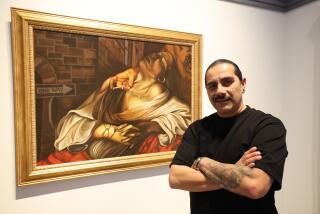Review: David Hockney makes great use of technology in ‘The Arrival of Spring’
In 2001, David Hockney stirred up some controversy when he published a book packed with pictures that argued — visually and convincingly — that many of the greatest painters of the Renaissance, including Jan van Eyck, Hans Holbein and Michelangelo Caravaggio, used specially fabricated glass lenses to compose their amazingly realistic masterpieces.
Most of the scholars and commentators who opposed Hockney’s ideas acted as if he had accused the Old Masters of cheating — of tracing the figures in their pictures rather than drawing them freehand. That was hardly Hockney’s point.
But the tattletale mentality of his detractors blinded them to the most exciting implications of his thinking: that advanced technology and the artist’s hand can work in concert to make images that move viewers by satisfying our senses while blowing our minds.
That’s what happens at L.A. Louver in “David Hockney: The Arrival of Spring, Part 1 of 3.” Compositionally, the 20 landscapes that make up the 77-year-old British artist’s 30th solo show in Los Angeles are perfectly ordinary.
In all but a few, a country lane leads your eye into a copse of trees whose newly blossomed leaves catch the sunshine and cast shadows on the ground below, creating flickering patterns that seem to be animated.
That’s just the beginning. Nearly every square inch of every large image is made up of strokes, dabs and flecks of shimmering color, not a single one of which runs into another, muddying things up. Both casual and dazzling, the clarity has lots in common with the way the world looks when you’re attuned to its nuances and every blade of grass appears to be a glorious symphony of color, texture and form.
The effect also recalls watercolors, painted by a virtuoso. But Hockney’s images are crisper and more vivid, their marks less organic and liquid than synthetic and gaseous — like rays of electronically transmitted light.
More important, the depth Hockney gets into his surfaces is impossible with watercolors. Most important, it’s a pleasure to get lost in, your eyeballs weaving their way through the sensuous spaces his luminous surfaces open.
It’s hard to believe that Hockney’s images are prints and that he drew them with a plastic stylus — and his fingertips — on the screen of an ordinary iPad, with off-the-shelf software.
If you’ve always assumed that handmade works, like paintings and drawing, provide satisfactions that cannot be had from digital images, you’re in for a big surprise. Hockney’s lyrical pictures of the English countryside around his childhood home compel viewers of all ages to throw off old-fashioned ideas about the supposedly intrinsic opposition between manually crafted and machine-made works.
That’s exactly what Hockney did 13 years ago in “Secret Knowledge: Rediscovering the Lost Techniques of the Old Masters.” His newest works are so beautiful that they may even persuade the tattletales to change their tune.
L.A. Louver Gallery, 45 N. Venice Blvd., (310) 822-4955, through Aug. 29. Closed Saturdays and Sundays. www.lalouver.com
More to Read
The biggest entertainment stories
Get our big stories about Hollywood, film, television, music, arts, culture and more right in your inbox as soon as they publish.
You may occasionally receive promotional content from the Los Angeles Times.






